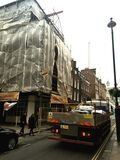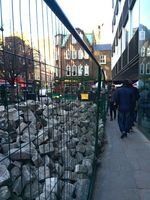
Crossrail 2 is proposing to knock down the Curzon Cinema building in Soho. As a general position we oppose the closure of any creative company or venue, Curzon included. It's a wonderful, longstanding part of the creative life of Soho, but the building is not pretty or historic - and other than the cinema it appears to be offices, though someone will probably put me right on that. This is set against the tsunami of change taking place in the heart of London, one of the most successful cities in the world.
Change is unavoidable and often for the good. But the fall out from huge infrastructure and building projects is often broken communities, displaced businesses and people - and decades of disruption. Giant lorries, earth moving machines, road closures, diversions, dust, noise and general chaos are fine on brown field sites in deserted areas, but they are out of place here in Soho with its 350-year history of creativity, small businesses, historic housing and tight-knit community. We are in danger of being at the mercy of a kind of wrecking-ball culture pursuing progress with ruthless vigour.
The scale of construction is not people friendly.

Let me be clear. I'm supportive of the majority of the property developments taking place particularly when they provide more creative space. It's the way they are carried out that we need to reappraise. There is a limit to the number of times the people who live and work in Soho can squeeze against a hoarding because another giant builders lorry has mounted the kerb to negotiate the historic little streets.
Everywhere we turn there are now ghastly wooden hoardings hiding muddy open cast mines digging deep under Soho or ripped plastic flapping in the wind half attached to steel scaffolding holding up a beautiful façade and nothing else.

It's a puzzle that our engineering advances have not been matched with more suitable project and equipment design. It feels like we are the victims of an eighteenth-century surgeon armed with saw and chisel, with 100 years still to go before keyhole surgery.
Any scheme that favours the contractors over the people, businesses and communities is bound to create friction. Just as it would if residents were favoured over contractors. Successful development is about balance, and we seem to be getting it wrong in Soho currently. Change can be good but it must avoid being clumsy.
Good design, sensitivity and creativity is the way forward.
I am writing this from our little pop up office in the middle of Soho Estates development in Brewer St. This seems to me to be a great example of good practice. The builders are in, doing what builders do, lots of muddy luminous jackets, fags, boots and drills. But in amongst it all have been a range of pop up shops, cafes and galleries. Where the builders don't need the space, it's being used for cultural and creative activity, ourselves included. The construction team and the creative businesses are sharing the space.

How do we prevent our building sites from creating huge no-go areas in our cities? How can we turn them into a celebration of city evolution and not muddy, boarded up holes in the ground? It's clear from the disruption at other sites that the building trade could learn a lot from the country's top designers on function and aesthetic. The construction industry should have to bring in the designers to look at how to shrink the building sites that sit at ground level, how to consult better and how to reduce the negative impact of these schemes. Just how small can we get the above ground sites? Skip and earth moving lorries should be half the size, more journeys, but less impact. This would force construction companies to do more recycling on site and to try and extract less from the site as the costs of doing so would increase. Construction must be more sensitive to the communities within which it takes place.
Make pain management the priority

It may be right to chop the leg off to save the body, but it really doesn't have to hurt so much. We have the creative skills and ingenuity to make it painless. As to what happens to the Curzon, the price of eviction should be rehousing, as it is for people. We should value our cultural amenities as much as we value the people who enjoy them.
For progress to work the evolution must be positive and sensitive. We must work much harder, utilising all our creative talent, to reduce the short term negative impacts of large infrastructure schemes to zero.
Images blogger's own
